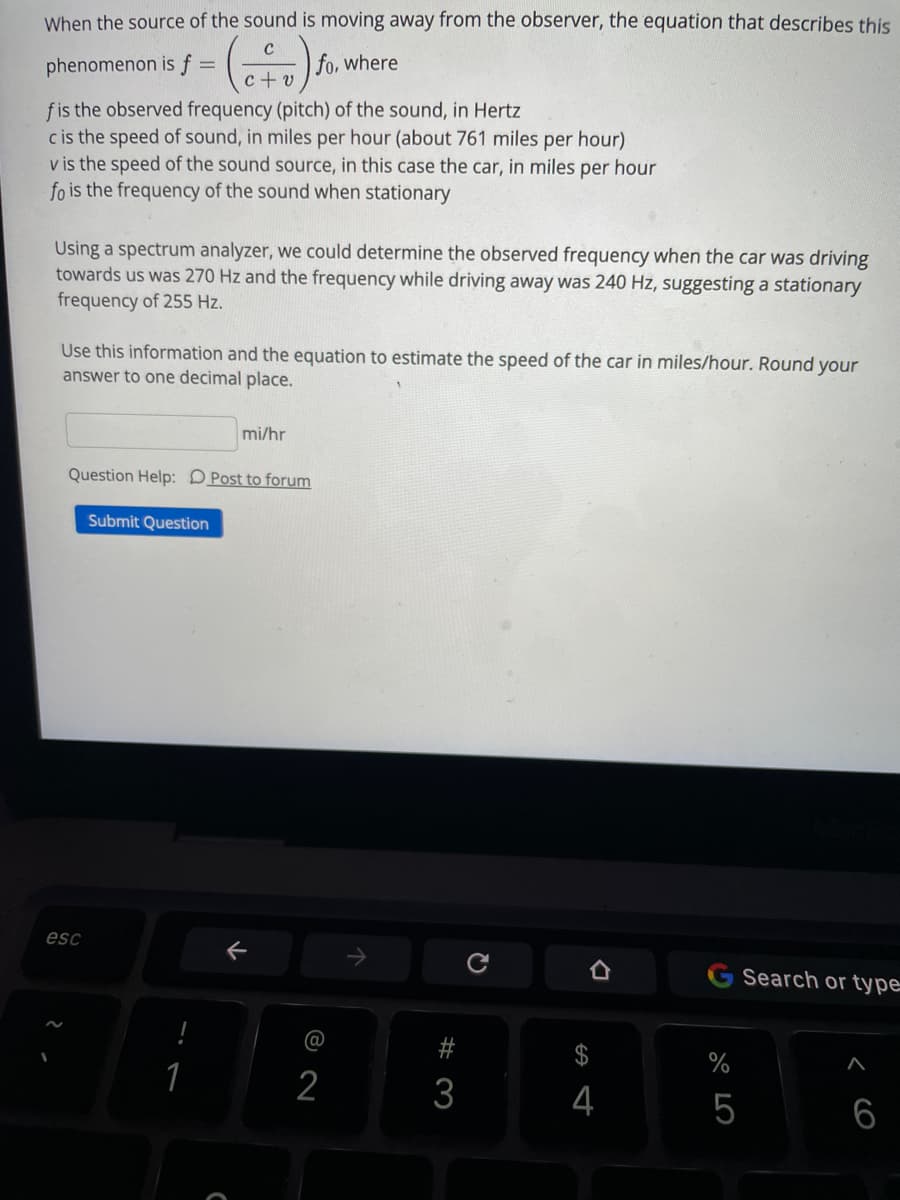SIu C phenomenon is f | fo, where %3D c + v fis the observed frequency (pitch) of the sound, in Hertz c is the speed of sound, in miles per hour (about 761 miles per hour) v is the speed of the sound source, in this case the car, in miles per hour fo is the frequency of the sound when stationary Using a spectrum analyzer, we could determine the observed frequency when the car was driving towards us was 270 Hz and the frequency while driving away was 240 Hz, suggesting a stationary frequency of 255 Hz. Use this information and the equation to estimate the speed of the car in miles/hour. Round your answer to one decimal place. mi/hr Question Help: DPost to forum Submit Question esc -> Search or type # % 1 2 3 4 5 6
SIu C phenomenon is f | fo, where %3D c + v fis the observed frequency (pitch) of the sound, in Hertz c is the speed of sound, in miles per hour (about 761 miles per hour) v is the speed of the sound source, in this case the car, in miles per hour fo is the frequency of the sound when stationary Using a spectrum analyzer, we could determine the observed frequency when the car was driving towards us was 270 Hz and the frequency while driving away was 240 Hz, suggesting a stationary frequency of 255 Hz. Use this information and the equation to estimate the speed of the car in miles/hour. Round your answer to one decimal place. mi/hr Question Help: DPost to forum Submit Question esc -> Search or type # % 1 2 3 4 5 6
Elementary Algebra
17th Edition
ISBN:9780998625713
Author:Lynn Marecek, MaryAnne Anthony-Smith
Publisher:Lynn Marecek, MaryAnne Anthony-Smith
Chapter8: Rational Expressions And Equations
Section8.9: Use Direct And Inverse Variation
Problem 8.183TI: The number of hours it takes for ice to melt varies inversely with the air temperature. Suppose a...
Related questions
Question
100%

Transcribed Image Text:When the source of the sound is moving away from the observer, the equation that describes this
C
phenomenon is f
fo, where
c + v
fis the observed frequency (pitch) of the sound, in Hertz
c is the speed of sound, in miles per hour (about 761 miles per hour)
v is the speed of the sound source, in this case the car, in miles per hour
fo is the frequency of the sound when stationary
Using a spectrum analyzer, we could determine the observed frequency when the car was driving
towards us was 270 Hz and the frequency while driving away was 240 Hz, suggesting a stationary
frequency of 255 Hz.
Use this information and the equation to estimate the speed of the car in miles/hour. Round your
answer to one decimal place.
mi/hr
Question Help: DPost to forum
Submit Question
esc
G Search or type
@
$
%
2
3
4
5
6
Expert Solution
This question has been solved!
Explore an expertly crafted, step-by-step solution for a thorough understanding of key concepts.
This is a popular solution!
Trending now
This is a popular solution!
Step by step
Solved in 2 steps with 2 images

Recommended textbooks for you

Elementary Algebra
Algebra
ISBN:
9780998625713
Author:
Lynn Marecek, MaryAnne Anthony-Smith
Publisher:
OpenStax - Rice University

Glencoe Algebra 1, Student Edition, 9780079039897…
Algebra
ISBN:
9780079039897
Author:
Carter
Publisher:
McGraw Hill

Algebra: Structure And Method, Book 1
Algebra
ISBN:
9780395977224
Author:
Richard G. Brown, Mary P. Dolciani, Robert H. Sorgenfrey, William L. Cole
Publisher:
McDougal Littell

Elementary Algebra
Algebra
ISBN:
9780998625713
Author:
Lynn Marecek, MaryAnne Anthony-Smith
Publisher:
OpenStax - Rice University

Glencoe Algebra 1, Student Edition, 9780079039897…
Algebra
ISBN:
9780079039897
Author:
Carter
Publisher:
McGraw Hill

Algebra: Structure And Method, Book 1
Algebra
ISBN:
9780395977224
Author:
Richard G. Brown, Mary P. Dolciani, Robert H. Sorgenfrey, William L. Cole
Publisher:
McDougal Littell


Algebra for College Students
Algebra
ISBN:
9781285195780
Author:
Jerome E. Kaufmann, Karen L. Schwitters
Publisher:
Cengage Learning

Intermediate Algebra
Algebra
ISBN:
9781285195728
Author:
Jerome E. Kaufmann, Karen L. Schwitters
Publisher:
Cengage Learning